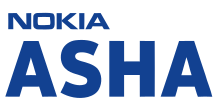Nokia Asha

Logo of Nokia Asha
|
|
| Manufacturer |
Nokia (2011—2014) Microsoft Mobile (2014) |
|---|---|
| Series | Asha |
| Compatible networks | 3G |
| Availability by country | 2011—2014 |
| Predecessor | Nokia Xseries |
| Related | Nokia 502, 501 |
| Operating system | Nokia OS |
| Storage | 128 |
| Removable storage | up to 32Gb |
| Display | 3.0 |
| Rear camera | 5 megapixel,Full LED flashlight |
| Connectivity | Bluetooth 3.0 |
| Other | Series 40, Nokia Asha platform |
| Development status | Discontinued |
The Nokia Asha series was a range of low-end feature phones produced and marketed by Nokia. The name "Asha" comes from the Hindi word meaning "hope".
On 3 September 2013, Microsoft announced its purchase of Nokia's mobile device business, with the deal closing on 25 April 2014. The company previously announced an intent to use Asha as an "on-ramp" to the Windows Phone platform, but in a company memo released in July 2014, it was announced that as part of cutbacks, Microsoft would end the Asha and Android-based Nokia X range entirely, in favor of solely producing Lumia Windows Phones and Nokia-branded "feature phone" products.
Below are the mobile phones in the Asha range. None of the Asha models have GPS functionality. All Asha phones include an FM radio.
The Asha 305 and Asha 311 models are known as the first generation of Asha Full Touch phones; the second generation is the Asha 50x line. All devices up to the Asha 50x series run the Nokia domestic operating system with Series 40 UI platform, also known as S40. The Asha 501 (released in May 2013), Asha 500, Asha 502,Asha 503 and Asha 230 (announced on 14 February 2014) are powered by the Nokia Asha platform, which builds on S40 and Smarterphone.
Dual camera/single camera
Nokia 206, 207, 208, and 301 are not part of the Asha series as they do not carry the "Asha" branding, despite mistakenly being marketed as such by carriers and retailers.
Nokia Xpress Browser uses intermediate Nokia proxy servers to optimize web pages based on the capabilities and screen size of the device. The proxy servers also compress data to reduce data transmission charges for the mobile user.
Like the Opera Mini, the Nokia Xpress browser decrypts and compresses HTTPS traffic, routing it through Nokia's own servers. This practice seeks to provide faster browsing for users of feature phones and smartphones with lower processing power and thus lower bills for mobile data usage. However, as pointed out by researcher, this raises serious privacy concerns, because Nokia is essentially "performing Man In The Middle Attack for sensitive HTTPS traffic" and temporarily decrypting user data—which could be sensitive financial information, passwords. The company admitted to the technical details, but stated, "Claims that we would access complete unencrypted information are inaccurate".GigaOm criticized Nokia, which, unlike the Opera Mini, has failed to make it clear that HTTPS traffic will be decrypted during transit. It recommended that Nokia learn from Amazon's Silk browser, which leaves HTTPS traffic undisturbed.
...
Wikipedia
